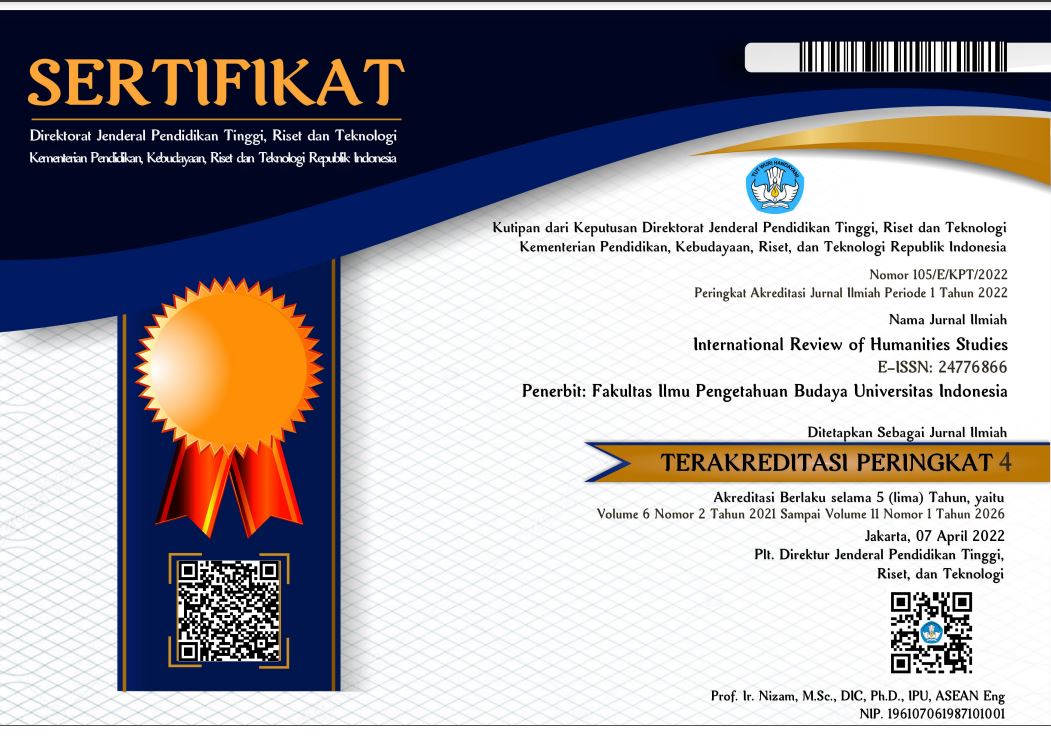International Review of Humanities Studies

Abstract
Arabic is a foreign language commonly spoken by many people all over the world; moreover, internationally, it plays such a strategic role. Nevertheless, Indonesian non-Muslims have a relatively low interest in Arabic. We can observe it from the relatively low number of non-Muslims who major in Arabic literature in various universities all over Indonesia. Therefore, this is such an interesting phenomenon to be studied. We think that this phenomenon takes place due to their inappropriate or incorrect perceptions towards Arabic. This study is aimed at identifying various factors affecting the perception of non-Muslim students of Faculty of Humanities of Universitas Indonesia (FIB-UI) in the Class of 2020 towards Arabic. This study employs a quantitative method with a descriptive approach. The participants in this study are non-Muslim students of Faculty of Cultural Sciences of Universitas Indonesia (FIB-UI) in the Class of 2020 with the samples amounting to 53 persons. To process the data of the study, we employ an exploratory factor analysis method. Based on the results of the study, it is found out that there are 5 factors affecting their perceptions such as the introduction factor, the Arabic characteristic factor, the assessment/assumption factor, the language-as-a-religious-identity factor, and the stereotypes-of-the-Muslims factor.
References
Books
Green, Lawrence. (1980). Health Education Planning A Diagnostic Approach. Baltimore.
The John Hopkins University, Mayfield Publishing Co.
Rakhmat, Jalaludin. (2005). Psikologi Komunikasi. Bandung: PT. Remaja Rosdakarya.
Restiyanti, P dan John J.O.I Ihwalauw. (2005). Perilaku Konsumen. Yogyakarta: Penerbit
ANDI.
Simamora, B. Analisis Multivariat Pemasaran. (2005). Jakarta: Gramedia Pustaka Utama.
Sugihartono, at all. (2007). Psikologi Pendidikan. Yogyakarta: UNY Press.
Sugiyono. (2017). Metode Penelitian Bisnis Pendekatan Kuantitatif, Kualitatif, Kombinasi,
dan R&D. Bandung: Alfabeta.
Walgito, Bimo. (2010). Pengantar Psikologi Umum. Yogyakarta: Andi.
Texts
Yuniati, D. (2016). Problem Pembelajaran Bahasa Arab Siswa Non Muslim Kelas III
Sekolah Menengah Atas Negeri (SMAN) 6 Kota Bengkulu (Analisis Teori Kognitif
Sosial Albert Bandura). UIN Sunan Kalijaga.
Journals
Jaradat, M. S. (2015). What’s really matter when choosing a college major. International
Journal of Arts and Commerce, 4 (2), 92-110.
Khausik, V & Walsh, C. (2019). Pragmatism as a Research Paradigm and Its Implications for
Social Work Research. Social Sciences Vol 3 No 255.
Letmiros, (2019). Arabic: Why Indonesians Heve to Learn It? Journal of International
Review of Humanities Studies. Vol.4, No 2.
Yahya, Y & dkk. (2020). De-sakralisasi dalam Pembelajaran Bahasa Arab di Indonesia:
Analisis Bahasa sebagai Identitas Agama. Jurnal Lingua Applicata Vol. 3 No.2:
57-70.
Conference Paper
UNESCO. (October, 2012). World Arabic Language Day : Eiplanatory notes concerning the
proposed World Arabic Language Day. The paper was presented on the interim agenda of the 190th session of the Executive Council at the request of Morocco and Saudi Arabia.
Internet
sidata-ptn.ltmpt.ac.id (2021). https://sidata-ptn.ltmpt.ac.id/ptn_sb.php Accessed on, 11 February
2021.
The World Factbook. (2022). World. Accessed on 13 May 2022, from
https://www.cia.gov/the-world-factbook/countries/world/
AnakUI.com (2015, 14 Maret). 5 Bahasa Asing yang Banyak Dipelajari Orang Indonesia. Accessed on 21 May 2022, 8:28 pm WIB from
https://www.anakui.com/5-bahasa-asing-yang-banyak-dipelajari-orang-indonesia/
Recommended Citation
Manurung, Catherine and Letmiros, Letmiros
(2023)
"FACTORS AFFECTING NON-MUSLIM STUDENTS OF FACULTY OF HUMANITIES OF UNIVERSITAS INDONESIA TOWARDS ARABIC,"
International Review of Humanities Studies: Vol. 8:
No.
1, Article 14.
DOI: 10.7454/irhs.v8i1.1013
Available at:
https://scholarhub.ui.ac.id/irhs/vol8/iss1/14


